
Ballroom dance is a set of European partner dances, which are enjoyed both socially and competitively around the world, mostly because of its performance and entertainment aspects. Ballroom dancing is also widely enjoyed on stage, film, and television.

Ice dance is a discipline of figure skating that historically draws from ballroom dancing. It joined the World Figure Skating Championships in 1952, and became a Winter Olympic Games medal sport in 1976. According to the International Skating Union (ISU), the governing body of figure skating, an ice dance team consists of one woman and one man.
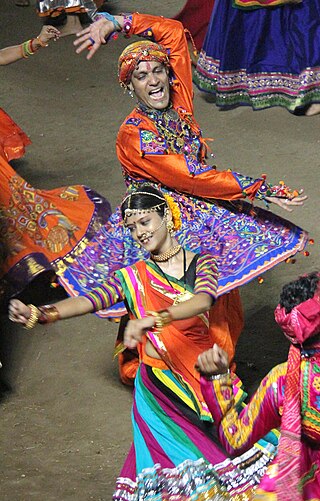
Garba is a form of Gujarati dance which originates from the state of Gujarat, India. The name is derived from the Sanskrit term Garbha. Many traditional garbas are performed around a centrally lit lamp or a picture or statue of the Hindu goddess Shakti. Traditionally, it is performed during the nine-day Hindu festival [Navratri]. Either the lamp or an image of the Goddess, Durga is placed in the middle of concentric rings as an object of veneration.

Gujarat, a western state of India, is known for music traditions of both folk and classical music.

Indian folk music is diverse because of India's enormous cultural diversity. It is sung in various languages and dialects throughout the length and breadth of this vast nation and exported to different parts of the world owing to migration.
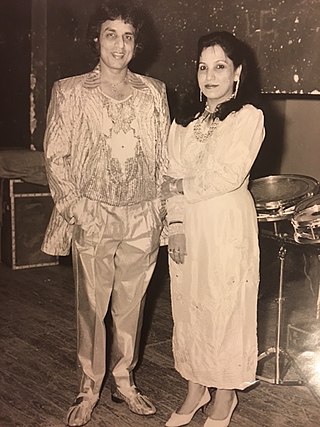
Laxmichand "Babla" Virji Shah and Kumari Kanchan Dinkarrao Mali-Shah were an Indian husband-wife musical group best known for work in the chutney music and Desi Folk music genres. They performed together for forty years until Kanchan died in 2004. Babla Shah is the younger brother of famous music director duo Kalyanji Anandji.
A dance squad or dance team, sometimes called a pom squad or song team, is a team that participates in competitive dance. A dance squad can also include: a jazz squad, ballet squad, or any kind of religion dance squad. Dance squads are a type of performance dance.
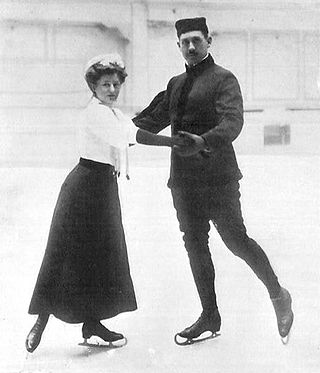
Pair skating is a figure skating discipline defined by the International Skating Union (ISU) as "the skating of two persons in unison who perform their movements in such harmony with each other as to give the impression of genuine Pair Skating as compared with independent Single Skating". The ISU also states that a pairs team consists of "one Woman and one Man". Pair skating, along with men's and women's single skating, has been an Olympic discipline since figure skating, the oldest Winter Olympic sport, was introduced at the 1908 Summer Olympics in London. The ISU World Figure Skating Championships introduced pair skating in 1908.

A show choir is a musical ensemble that combines choral singing with choreographed dance, often with an overarching theme. It is most relevant in the Midwestern United States and was popularized by the American television show Glee.

Irish stepdance is a style of performance dance with its roots in traditional Irish dance. It is generally characterized by a stiff upper body and fast and precise movements of the feet. It can be performed solo or in groups. Aside from public dance performances, there are also stepdance competitions all over the world. These competitions are often called Feiseanna. In Irish dance culture, a Feis is a traditional Gaelic arts and culture festival. Costumes are considered important for stage presence in competition and performance Irish stepdance. In many cases, costumes are sold at high prices and can even be custom made. Each costume is different, with varying colors and patterns, designed to attract the judge's eye in competitions and the audience's eye in performance. General appearance beside the costume is also equally important. Female dancers would typically curl their hair before each competition or wear curled wigs, while male dancers would neatly style their hair to a shape to their liking. Poodle Socks are worn by female dancers while males wear plain black socks. Poodle socks are white socks that stretch to typically 1-4 inches above the ankle, depending on the dancers preference. They also have distinctive ribbing, and can be embroidered with gems.

Twirling is a form of object manipulation where an object is twirled by one or two hands, the fingers or by other parts of the body. Twirling practice manipulates the object in circular or near circular patterns. It can also be done indirectly by the use of another object or objects as in the case of devil stick manipulation where handsticks are used. Twirling is performed as a hobby, sport, exercise or performance.
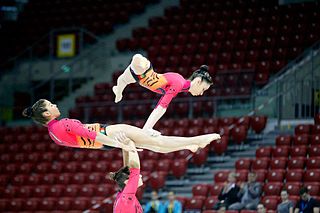
Acrobatic gymnastics is a competitive discipline of gymnastics where partnerships of gymnasts work together and perform figures consisting of acrobatic moves, dance and tumbling, set to music. There are three types of routines; a 'balance' routine where the focus is on strength, poise and flexibility; a 'dynamic' routine which includes throws, somersaults and catches, and a 'combined' routine which includes elements from both balance and dynamic.

Aerobic gymnastics or sport aerobics is a competitive sport originating from traditional aerobics in which complex, high-intensity movement patterns and elements of varying difficulty are performed to music.

You Can Dance – Po prostu tańcz! is a televised Polish dance competition with a format based on the American show So You Think You Can Dance. Dancers compete to win PLN 100,000, and a 3-month scholarship in dance school Broadway Dance Center and International Dance Academy in Los Angeles from season 7 on. The winners to date are : Maciek "Gleba" Florek, Artur Cieciórski, Wiola Fiuk, Ania Kapera, Jakub Jóżwiak, Dominik Olechowski, Brian Poniatowski, Mateusz Sobecko and Stefano Silvino.
So You Think You Can Dance (SYTYCD) is an American reality television dance competition show that aired on Fox in the United States and is the flagship series of the international So You Think You Can Dance television franchise. It was created by American Idol producers Simon Fuller and Nigel Lythgoe and is produced by 19 Entertainment and Dick Clark Productions The series premiered on July 20, 2005, with over ten million viewers and ended the summer season as the top-rated show on television. The first season was hosted by American news personality Lauren Sánchez. Since the second season, it has been hosted by English former children's television personality and game show emcee Cat Deeley.
In Minnesota, high school dance teams are scored by a designated set of officials during a competition. Each official is required to follow judging criteria regulated by the Minnesota State High School League. Routines are measured and recorded on a judging criteria rubric during a performance and given to the team for review after the competition is complete. Each judging criteria sheet contains categories in which teams will receive a score from one to ten, one being considered very poor and 10 being superior. Points will be totaled and the final score will be measured out of one hundred. Throughout all three classes; A, AA, and AAA, and in both divisions; High Kick and Jazz, the judging rubric remains consistent.
In Australia, competitive cheerleading is a minor sport, seeing over a 10,000% increase in athlete participation between 2000 and 2022. This growth happened through a 15–20% increase in participation each year between 2006 and 2016.
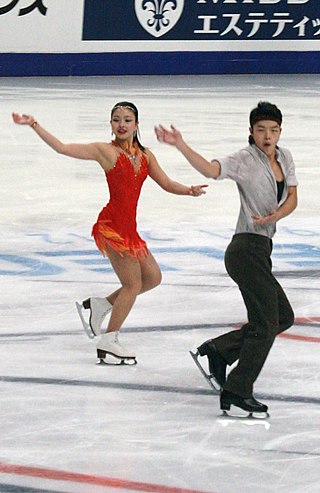
Ice dance, a discipline of figure skating, has required elements that make up a well-balanced rhythm dance program and free dance program, which must be performed during competitions. They include: the dance lift, the dance spin, the step sequence, turn sequences, and choreographic elements. The elements must be performed in specific ways, as described by published communications by the International Skating Union (ISU), unless otherwise specified. The ISU has also provided a list of illegal movements.
A choreographic sequence is a required element for figure skating in all international competitions. It is required in the free skating programs of senior and junior single skaters and in the free skating programs of senior pair skaters. It is also required during ice dancers' rhythm dances and free dances. Judges do not evaluate individual elements in a choreographic sequence; rather, they note that it was accomplished. Skaters must fulfill certain requirements to fulfill the highest points possible during choreographic sequences. There are six types of choreographic elements in ice dance: the Choreographic lift, the Choreographic spinning movement, the Choreographic assisted jump movement, the Choreographic twizzling movement, the Choreographic sliding movement, and the Choreographic character step sequence.
















